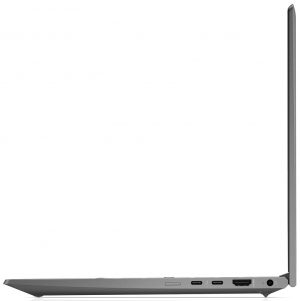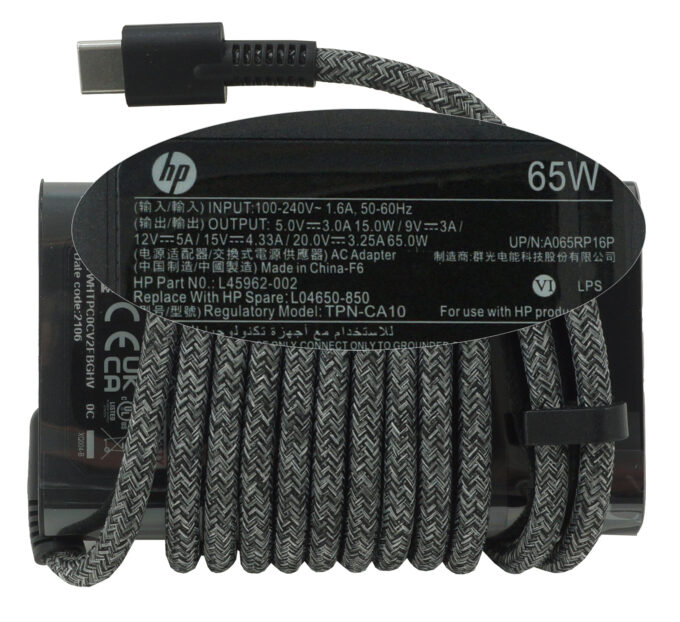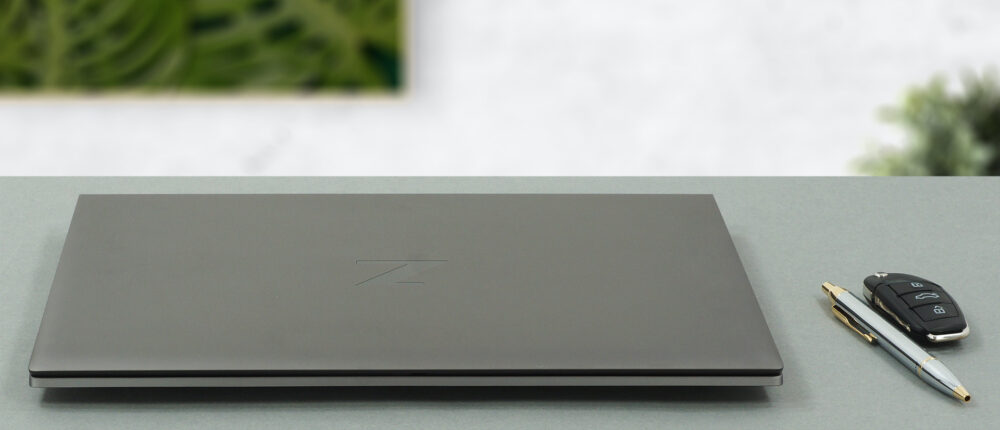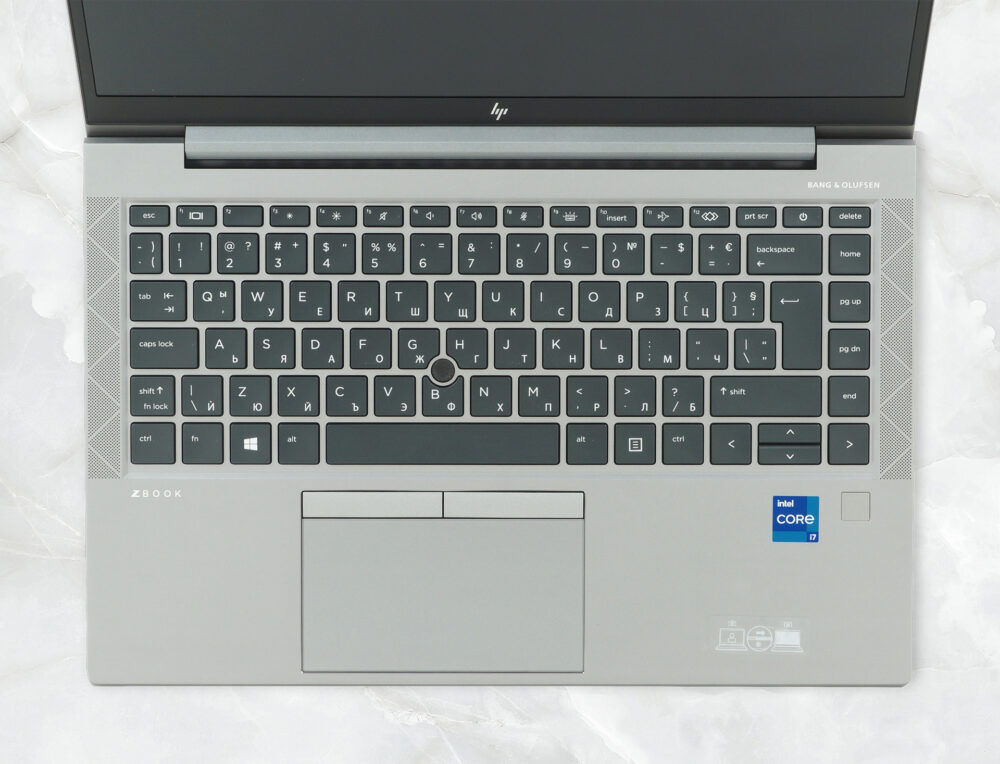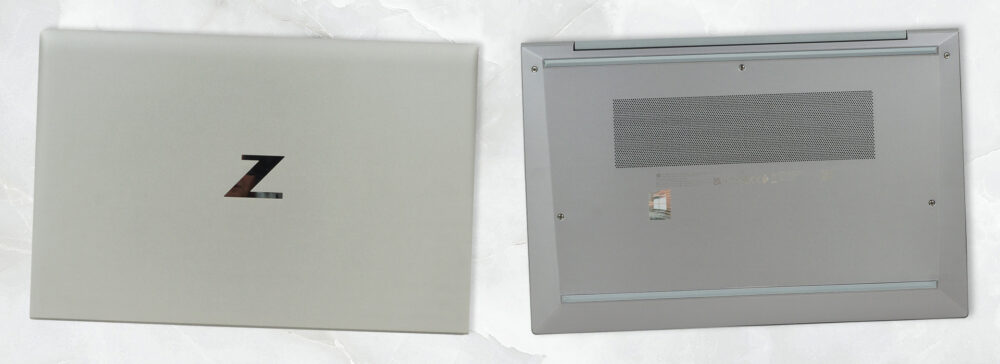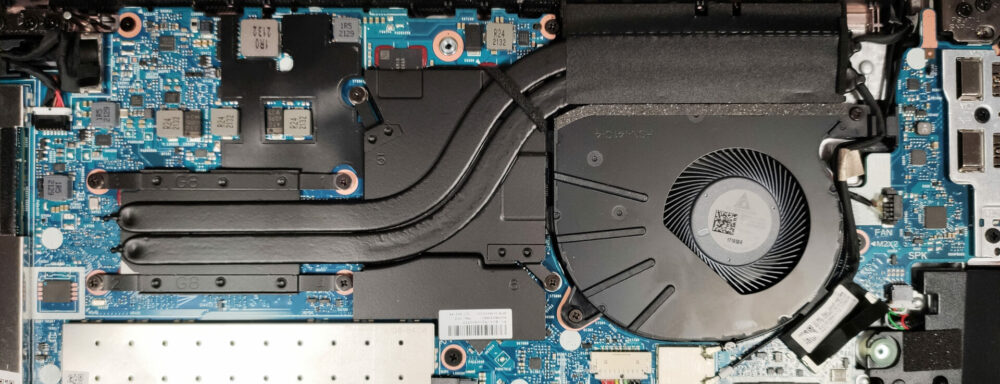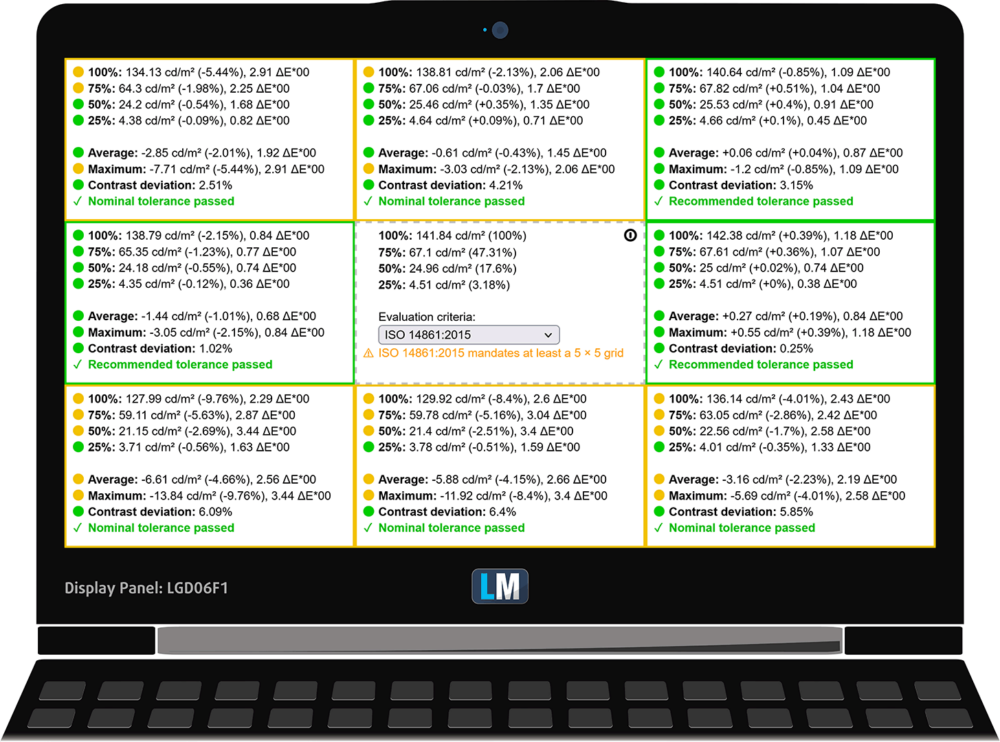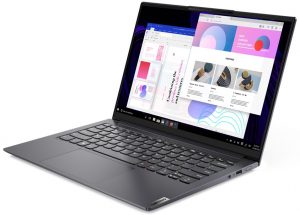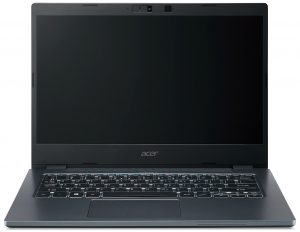HP ZBook Firefly 14 G8 review – near silent mobile workstation
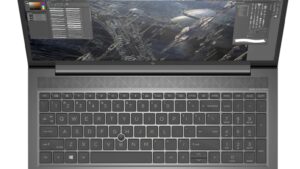 These days, a mobile workstation is something normal – thanks to technology advancement, we have some fast mobile CPUs and iGPUs that are good enough for such devices. Because of the latest-gen processors from both Intel and AMD, more powerful chips can be fitted in smaller and thinner laptops. Today’s case is exactly the same – we got the HP ZBook Firefly 14 G8 which is a compact workstation that can be equipped with an optional NVIDIA Quadro GPU. Years ago, a 14-inch workstation was “mission impossible”.
These days, a mobile workstation is something normal – thanks to technology advancement, we have some fast mobile CPUs and iGPUs that are good enough for such devices. Because of the latest-gen processors from both Intel and AMD, more powerful chips can be fitted in smaller and thinner laptops. Today’s case is exactly the same – we got the HP ZBook Firefly 14 G8 which is a compact workstation that can be equipped with an optional NVIDIA Quadro GPU. Years ago, a 14-inch workstation was “mission impossible”.
This HP device can be configured with Intel Tiger Lake-UP3 CPUs (vPro models are available too) which looks like the right decision because these chips don’t dissipate too much heat making them suitable for smaller laptops like the HP ZBook Firefly 14 G8. The only GPU option is the NVIDIA Quadro T500, based on the GeForce MX450 – this GPU is a 25W version of GeForce GTX 1650. Interestingly, there is a small catch here – if you want a dGPU (ergo, the GeForce T500) your device will be stuck with soldered memory only (yes, no additional SODIMMs). At least you can configure it before buying with up to 32GB of DDR4 RAM which doesn’t sound that bad.
In terms of display variants, this machine can be picked with five (yes, 5) different 1080p IPS displays – one of them is a touchscreen model, there is a panel with HP Dream Color, and another one with HP Sure View for additional privacy.
If you don’t care about dGPU performance and you need a lot of memory for specific workloads, the iGPU-only devices come with two RAM slots that can handle up to 64GB of DDR4 memory. So, yeah, it’s up to you and your preferences in this situation. The laptop can be ordered with some optional goodies like a Nano SIM card slot, NFC, fingerprint reader, SmartCard slot, IR WebCam, and even the backlight of the keyboard is optional. Alright, enough talking, let’s inspect the HP ZBook Firefly 14 G8.
You can check the prices and configurations in our Specs System: https://laptopmedia.com/series/hp-zbook-firefly-14-g8/
Contents
Specs Sheet
- HDD/SSD
- up to 8000GB SSD
- M.2 Slot
- 1x 2280 NVMe See photo
- RAM
- up to 64GB
- OS
- Windows 10 Pro, Windows 11 Pro
- Battery
- 53Wh, 3-cell
- Body material
- Aluminum
- Dimensions
- 323 x 214.6 x 17.9 mm (12.72" x 8.45" x 0.70")
- Weight
- 1.35 kg (3 lbs)
- Ports and connectivity
- 1x USB Type-A
- 3.2 Gen 1 (5 Gbps)
- 1x USB Type-A
- 3.2 Gen 1 (5 Gbps), Power Delivery (PD)
- 2x USB Type-C
- Thunderbolt 4, Power Delivery (PD), DisplayPort, Sleep and Charge
- HDMI
- 1.4b
- Wi-Fi
- 802.11ax
- Bluetooth
- 5.0
- Audio jack
- 3.5mm Combo Jack
- Features
- Fingerprint reader
- Web camera
- HD
- Backlit keyboard
- Microphone
- Dual Array Digital Microphone
- Speakers
- 2 Speakers, Bang & Olufsen
- Optical drive
All HP ZBook Firefly 14 G8 configurations
What’s in the box?
The package isn’t something special, it contains the laptop itself, a 65W USB Type-C power adapter (the iGPU-only variants come with a 45W adapter), and manuals.
Design and construction
At first glance, this device looks very similar to HP EliteBook 830 G8 and it really is. The laptop looks good thanks to its (almost) aluminum build but the huge ZBook symbol placement is a bit of an odd design idea. Dimensions-wise, we have a profile of 180mm, and the machine scales at 1.35 kilos – good.
The lid can be easily opened with a single hand thanks to the perfectly stiffed hinges and we can spot thin (and plastic) bezels around the display. The 720p WebCam has an orthodox position, a hardware privacy shutter, and there is optional IR face recognition.
The base houses a NumberPad-less spill-resistant keyboard that has an optional backlight. The keyboard is a good unit – it has nice and long key travel, the keycaps have a decent “click”, and there is a dual pointstick. Unfortunately, the “Up” and “Down” Arrow keys are half-sized. By the way, this keyboard is silent even when you type harshly.
The Bang & Olufsen speakers are placed on both sides of the keyboard.
The touchpad has a glass surface and it’s a pleasure to use it – there are two dedicated buttons, gliding is good as well the accuracy.
There isn’t much to say about the bottom plate – it houses two large rubber feet and a big ventilation grille. The hot air is exhausted from the back but unfortunately, the air is pushed through the hinge cover and it warms the display during load.
Ports
On the left side, there is a Nano security lock slot, two USB Type-A 3.1 (Gen. 1) ports (the first one has Power Delivery capabilities), an audio combo jack, and a Smart Card reader (optional). On the right, you can see spot a power plug, an HDMI 1.4b connector, two USB Type-C ports with Power Delivery and Display Port capabilities, and an optional Nano SIM card slot.
Disassembly, upgrade options and maintenance
For popping the bottom plate, you have to undo five captive Phillips-head screws and then you can use a pry tool to remove the panel.
A tin chassis and we got two thin heat pipes for CPU and GPU cooling. There is a decently-sized single cooling fan and a big cooling plate.
Below the two metal brackets, we can find an M.2 slot for fast NVMe drives and soldered memory. In our case, beneath the second metal cover, we have 16GB DDR4-3200MHz RAM in dual-channel mode. The devices with dGPU can be configured with up to 32GB of DDR4-3200MHz soldered memory, while the models with iGPU-only have two SODIMM slots that can handle up to 64GB of DDR4-3200MHz memory.
The battery is a 53Wh unit that has to handle the 14-incher when it’s not plugged into the wall AC.
Display quality
The HP ZBook Firefly 14 G8 we’ve bought has an IPS panel, model number LGD06F1. Its diagonal is 14″ (35.6 cm), and the resolution 1920 х 1080 pixels. The screen ratio is 16:9, and we are looking at a pixel density of – 157 ppi, and a pitch of 0.16 х 0.16 mm. The screen turns into Retina when viewed at distance equal to or greater than 55cm (22.7″) (from this distance one’s eye stops differentiating the separate pixels, and it is normal for looking at a laptop).
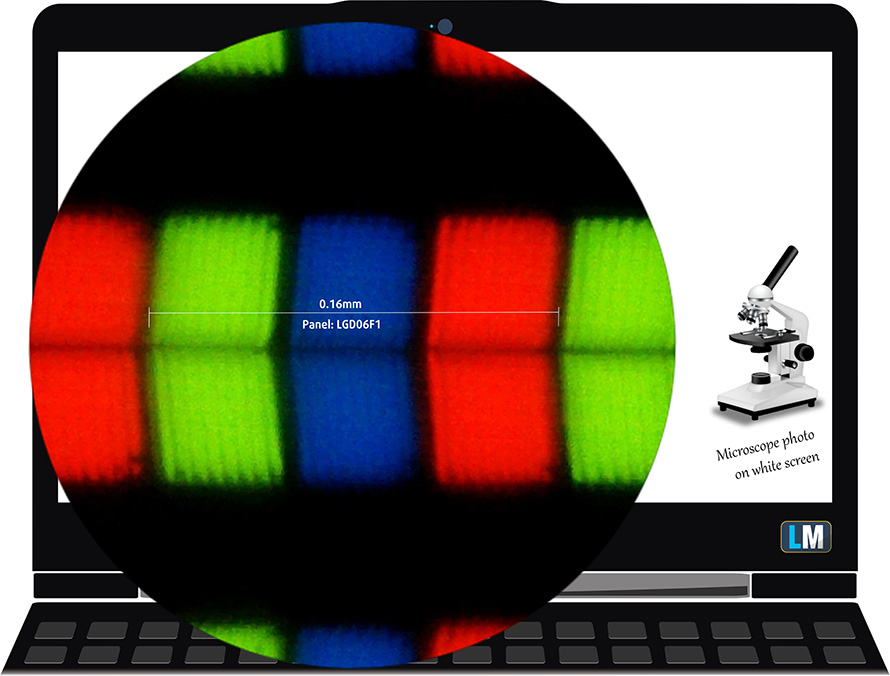
The viewing angles are comfortable. We offer images at 45° to evaluate image quality.
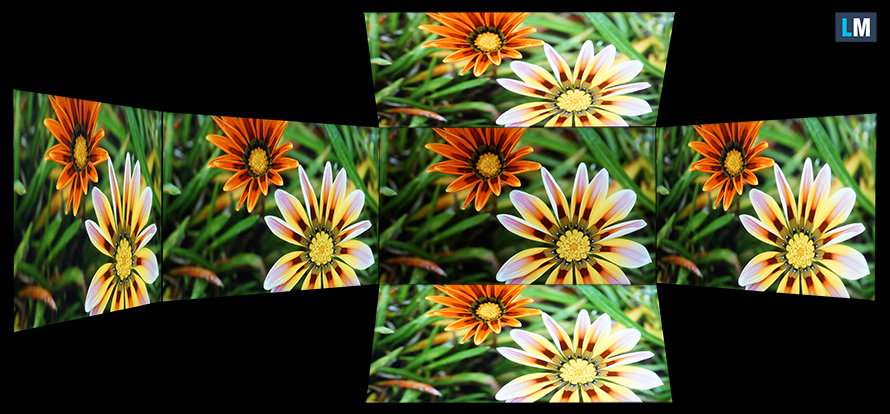
This is a video with a locked focus and exposure.
The measured maximum brightness of 274 nits in the middle of the screen and 264 nits as an average for the whole area, with a maximum deviation of 10%. The Correlated Color Temperature on a white screen is 5880K – slightly warmer than the optimal for the sRGB standard of 6500K.
In the illustration below you can see how the display performs from a uniformity perspective. In other words, the leakage of light from the light source.
Values of dE2000 over 4.0 should not occur, and this parameter is one of the first you should check if you intend to use the laptop for color-sensitive work. The contrast ratio is very good – 1150:1.
To make sure we are on the same page, we would like to give you a little introduction to the sRGB color gamut and the Adobe RGB. To start, there’s the CIE 1976 Uniform Chromaticity Diagram that represents the visible specter of colors by the human eye, giving you a better perception of the color gamut coverage and the color accuracy.
Inside the black triangle, you will see the standard color gamut (sRGB) that is being used by millions of people in HDTV and on the web. As for the Adobe RGB, this is used in professional cameras, monitors, etc for printing. Basically, colors inside the black triangle are used by everyone and this is the essential part of the color quality and color accuracy of a mainstream notebook.
Still, we’ve included other color spaces like the famous DCI-P3 standard used by movie studios, as well as the digital UHD Rec.2020 standard. Rec.2020, however, is still a thing of the future and it’s difficult for today’s displays to cover that well. We’ve also included the so-called Michael Pointer gamut, or Pointer’s gamut, which represents the colors that naturally occur around us every day.
The yellow dotted line shows HP ZBook Firefly 14 G8’s color gamut coverage.
Its display covers 52% of the sRGB/ITU-R BT.709 (web/HDTV standard) in CIE1976.
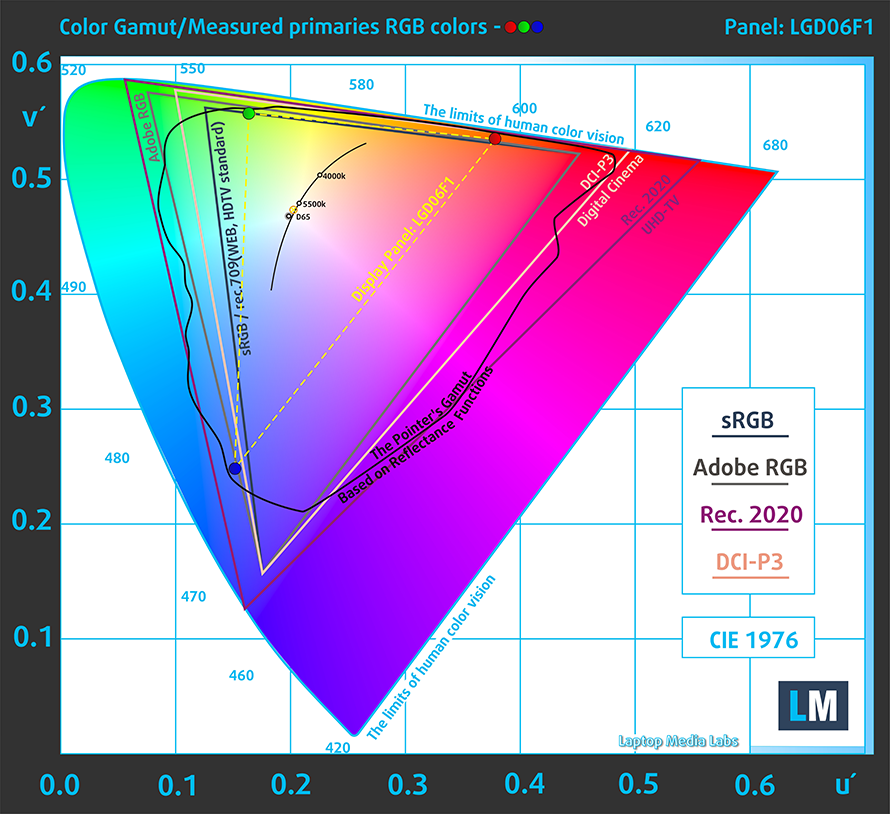
Our “Design and Gaming” profile delivers optimal color temperature (6500K) at 140 cd/m2 luminance and sRGB gamma mode.
We tested the accuracy of the display with 24 commonly used colors like light and dark human skin, blue sky, green grass, orange, etc. You can check out the results at factory condition and also, with the “Design and Gaming” profile.
Below you can compare the scores of HP ZBook Firefly 14 G8 with the default settings (left), and with the “Gaming and Web design” profile (right).
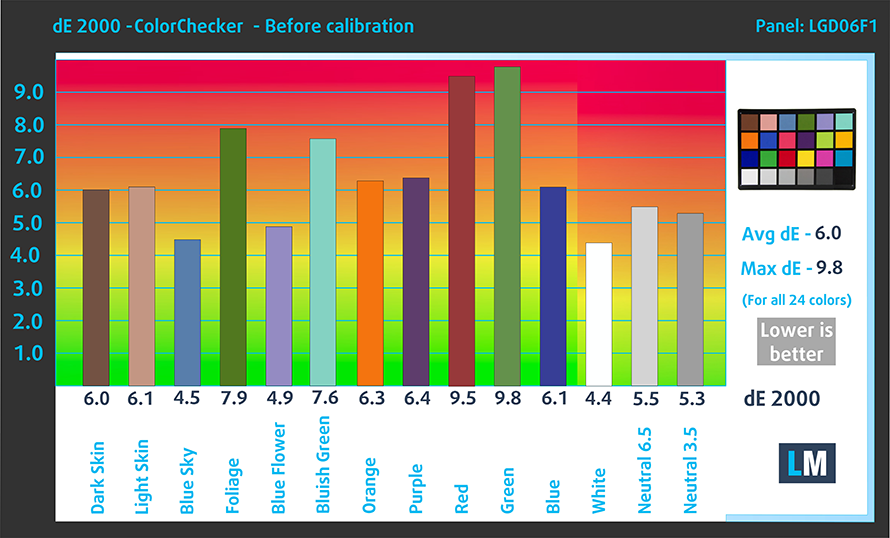
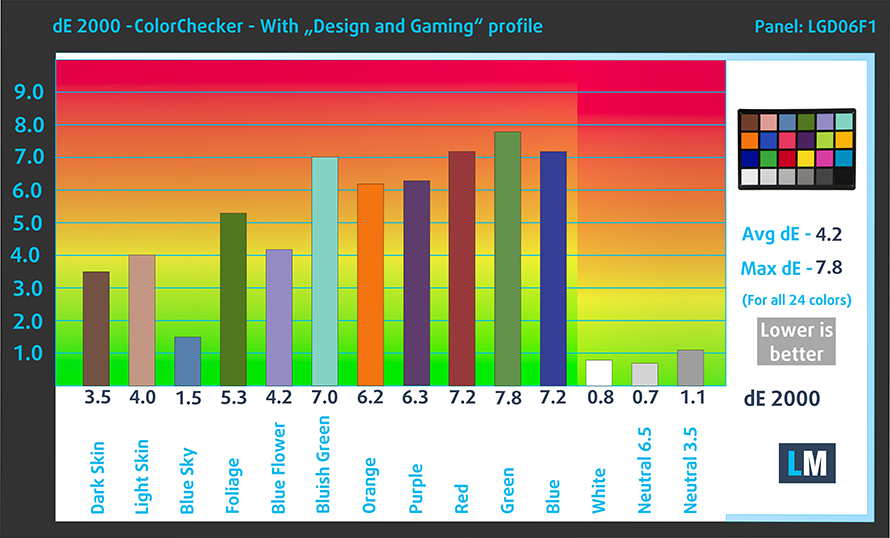
The next figure shows how well the display is able to reproduce really dark parts of an image, which is essential when watching movies or playing games in low ambient light.
The left side of the image represents the display with stock settings, while the right one is with the “Gaming and Web Design” profile activated. On the horizontal axis, you will find the grayscale, and on the vertical axis – the luminance of the display. On the two graphs below you can easily check for yourself how your display handles the darkest nuances but keep in mind that this also depends on the settings of your current display, the calibration, the viewing angle, and the surrounding light conditions.
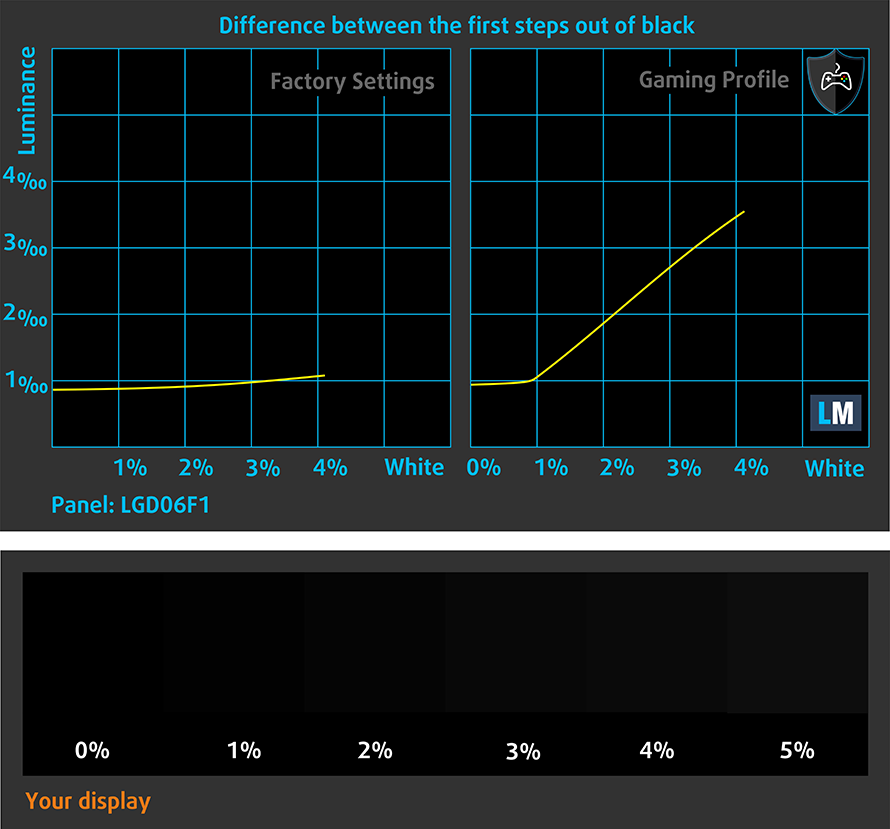
Response time (Gaming capabilities)
We test the reaction time of the pixels with the usual “black-to-white” and “white-to-black” method from 10% to 90% and vice versa.
We recorded Fall Time + Rise Time = 25 ms.
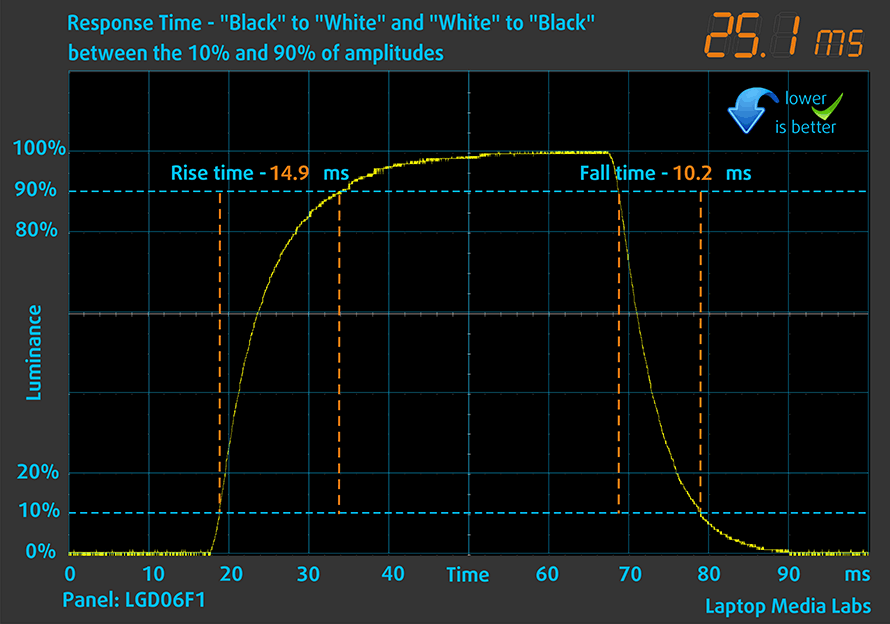
After that, we test the reaction time of the pixels with the usual “Gray-to-Gray” method from 50% White to 80% White and vice versa between 10% and 90% of the amplitude.
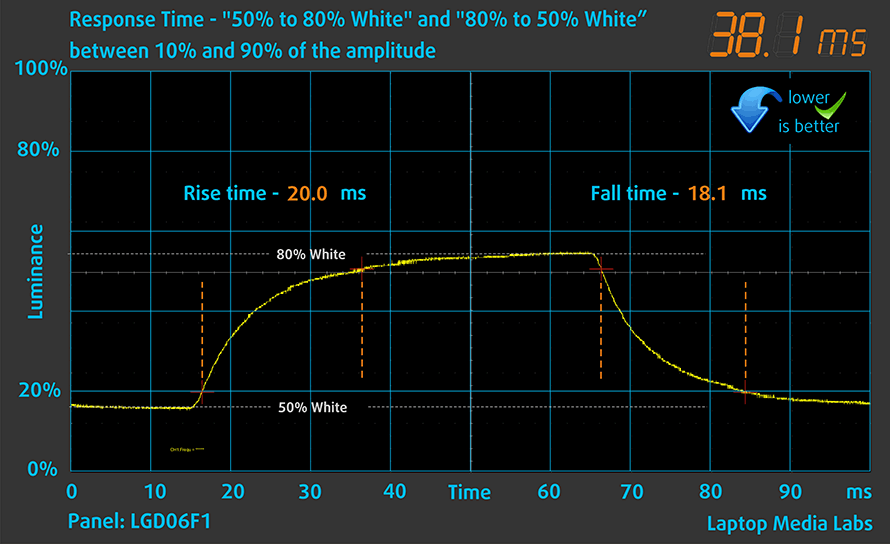
PWM (Screen flickering)
Pulse-width modulation (PWM) is an easy way to control monitor brightness. When you lower the brightness, the light intensity of the backlight is not lowered, but instead turned off and on by the electronics with a frequency indistinguishable to the human eye. In these light impulses, the light/no-light time ratio varies, while brightness remains unchanged, which is harmful to your eyes. You can read more about that in our dedicated article on PWM.
HP ZBook Firefly 14 G8’s panel is PWM-free at any brightness level. This means prolonged periods of usage aren’t a problem here.
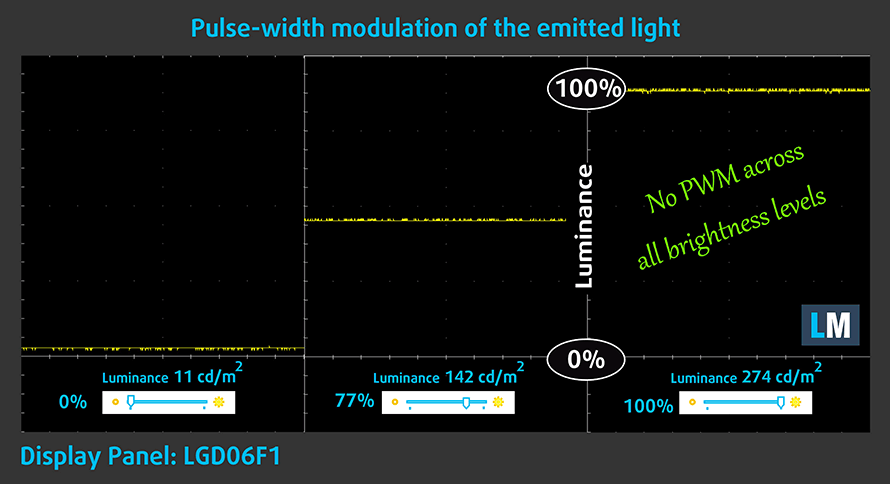
Blue light emissions
Installing our Health-Guard profile not only eliminates PWM but also reduces the harmful Blue Light emissions while keeping the colors of the screen perceptually accurate. If you’re not familiar with the Blue light, the TL;DR version is – emissions that negatively affect your eyes, skin, and your whole body. You can find more information about that in our dedicated article on Blue Light.
Buy our profiles
Since our profiles are tailored for each individual display model, this article and its respective profile package are meant for HP ZBook Firefly 14 G8 configurations with 14″ FHD IPS LGD06F1.
*Should you have problems with downloading the purchased file, try using a different browser to open the link you’ll receive via e-mail. If the download target is a .php file instead of an archive, change the file extension to .zip or contact us at [email protected].
Read more about the profiles HERE.
In addition to receiving efficient and health-friendly profiles, by buying LaptopMedia's products you also support the development of our labs, where we test devices in order to produce the most objective reviews possible.

Office Work
Office Work should be used mostly by users who spend most of the time looking at pieces of text, tables or just surfing. This profile aims to deliver better distinctness and clarity by keeping a flat gamma curve (2.20), native color temperature and perceptually accurate colors.

Design and Gaming
This profile is aimed at designers who work with colors professionally, and for games and movies as well. Design and Gaming takes display panels to their limits, making them as accurate as possible in the sRGB IEC61966-2-1 standard for Web and HDTV, at white point D65.

Health-Guard
Health-Guard eliminates the harmful Pulse-Width Modulation (PWM) and reduces the negative Blue Light which affects our eyes and body. Since it’s custom tailored for every panel, it manages to keep the colors perceptually accurate. Health-Guard simulates paper so the pressure on the eyes is greatly reduced.
Get all 3 profiles with 33% discount
Sound
HP ZBook Firefly 14 G8’s Bang & Olufsen speakers produce a very good quality sound with a pretty high maximum volume. Additionally, its low, mid and high tones are clear of deviations.
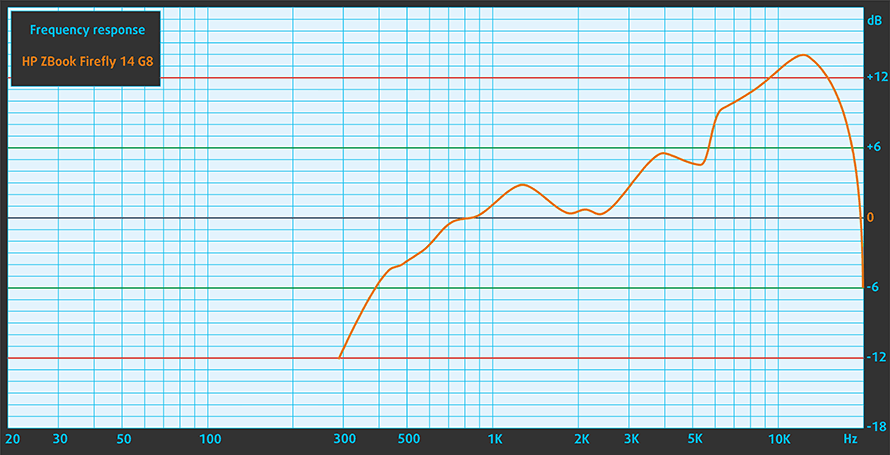
Drivers
All of the drivers and utilities for this notebook can be downloaded from here: https://support.hp.com/us-en/drivers/selfservice/hp-zbook-firefly-14-inch-g8-mobile-workstation-pc/2100000206
Battery
Now, we conduct the battery tests with Windows Better performance setting turned on, screen brightness adjusted to 120 nits, and all other programs turned off except for the one we are testing the notebook with. The notebook’s 53Wh battery pack lasts for over 16 hours of Web browsing, and 14 hours and 17 minutes of video playback. This is an impressive result.
In order to simulate real-life conditions, we used our own script for automatic web browsing through over 70 websites.
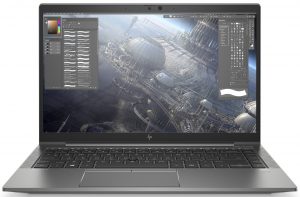
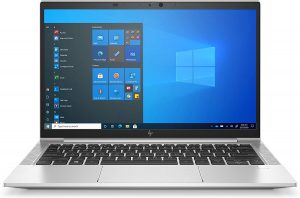
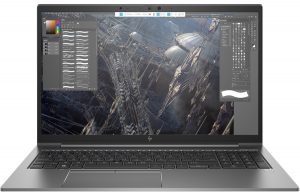
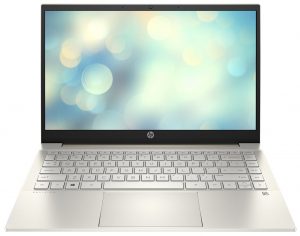
For every test like this, we use the same video in HD.




CPU options
According to HP’s website, you can get the HP ZBook Firefly 14 G8 with Core i5-1135G7, Core i7-1165G7, Core i5-1145G7 (vPro), and Core i7-1185G7 (vPro).
Results are from the Cinebench 20 CPU test (the higher the score, the better)
Results are from our Photoshop benchmark test (the lower the score, the better)
HP ZBook Firefly 14 G8 CPU variants
Here you can see an approximate comparison between the CPUs that can be found in the HP ZBook Firefly 14 G8 models on the market. This way you can decide for yourself which HP ZBook Firefly 14 G8 model is the best bang for your buck.
Note: The chart shows the cheapest different CPU configurations so you should check what the other specifications of these laptops are by clicking on the laptop’s name / CPU.
Results are from the Cinebench R23 CPU test (the higher the score, the better)
Results are from our Photoshop benchmark test (the lower the score, the better)
GPU options
The only dGPU that is available for configuring is the NVIDIA Giadro T500. The iGPU-only based machines come with the Intel Iris Xe Graphics G7 (96EU) and Intel Iris Xe Graphics G7 (80EU) depending on the CPU that is fitted inside of the laptop.
Results are from the 3DMark: Time Spy (Graphics) benchmark (higher the score, the better)
Results are from the 3DMark: Fire Strike (Graphics) benchmark (higher the score, the better)
Results are from the Unigine Superposition benchmark (higher the score, the better)
HP ZBook Firefly 14 G8 GPU variants
Here you can see an approximate comparison between the GPUs that can be found in the HP ZBook Firefly 14 G8 models on the market. This way you can decide for yourself which HP ZBook Firefly 14 G8 model is the best bang for your buck.
Note: The chart shows the cheapest different GPU configurations so you should check what the other specifications of these laptops are by clicking on the laptop’s name / GPU.
Results are from the 3DMark: Time Spy (Graphics) benchmark (higher the score, the better)
Results are from the 3DMark: Fire Strike (Graphics) benchmark (higher the score, the better)
Results are from the 3DMark: Wild Life (Graphics) benchmark (higher the score, the better)
Results are from the Unigine Superposition benchmark (higher the score, the better)
Gaming tests
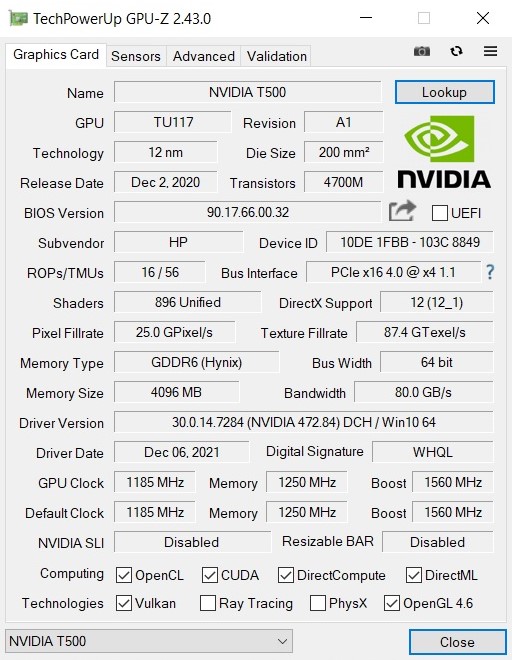
| Assassin’s Creed Valhalla | Full HD, Low (Check settings) | Full HD, Medium (Check settings) | Full HD, High (Check settings) | Full HD, Ultra (Check settings) |
|---|---|---|---|---|
| Average FPS | 27 fps | 19 fps | – | – |
| Metro Exodus | Full HD, Low (Check settings) | Full HD, High (Check settings) | Full HD, Extreme (Check settings) |
|---|---|---|---|
| Average FPS | 43 fps | 17 fps | – |
| Gears 5 | Full HD, Low (Check settings) | Full HD, Medium (Check settings) | Full HD, High (Check settings) | Full HD, Ultra (Check settings) |
|---|---|---|---|---|
| Average FPS | 61 fps | 35 fps | 27 fps | 21 fps |
Temperatures and comfort
Max CPU load
In this test we use 100% on the CPU cores, monitoring their frequencies and chip temperature. The first column shows a computer’s reaction to a short load (2-10 seconds), the second column simulates a serious task (between 15 and 30 seconds), and the third column is a good indicator of how good the laptop is for long loads such as video rendering.
Average core frequency (base frequency + X); CPU temp.
| Intel Core i7-1165G7 (15W TDP) | 0:02 – 0:10 sec | 0:15 – 0:30 sec | 10:00 – 15:00 min |
|---|---|---|---|
| HP ZBook Firefly 14 G8 | 3.24 GHz (B+16%) @ 90°C @45W | 2.92 GHz (B+4%) @ 74°C @ 30W | 2.25 GHz (B-20%) @ 61°C @18W |
| Dell Latitude 14 5420 | 3.80 GHz (B+36%) @ 98°C @ 51W | 3.27 GHz (B+17%) @ 98°C @ 35W | 2.78 GHz @ 96°C @ 26W |
| HP EliteBook x360 1040 G8 | 3.43 GHz (B+23%) @ 98°C @ 40W | 2.84 GHz (B+1%) @ 88°C @ 27W | 2.43 GHz @ 69°C @ 17W |
| HP Elite Dragonfly G2 | 3.17 GHz (B+13%) @ 98°C @ 34W | 2.34 GHz @ 76°C @ 18W | 2.14 GHz @ 73°C @ 16W |
| Lenovo Yoga Slim 7i Pro (14) | 3.90 GHz (B+39%) @ 85°C @ 61W | 2.57 GHz @ 69°C @ 26W | 2.37 GHz @ 57°C @ 20W |
| HP Pavilion 14 (14-dv0000) | 3.08 GHz (B+10%) @ 91°C @ 40W | 2.79 GHz @ 89°C @ 29W | 2.13 GHz @ 71°C @ 18W |
| Acer TravelMate P4 (TMP414-51) | 2.99 GHz (B+7%) @ 94°C @ 33W | 2.66 GHz @ 93°C @ 27W | 1.86 GHz @ 68°C @ 16W |
| Acer Swift 3X (SF314-510G) | 3.74 GHz (B+34%) @ 95°C @ 45W | 3.45 GHz (B+23%) @ 95°C @ 37W | 3.09 GHz (B+10%) @ 85°C @ 28W |
A look at the chart and we can see that the cooling solution is doing a decent job (for a slim and compact device like this one) in short to medium loads. Sadly, when you apply a serious load, the processor’s clock drops down below its base clock to 2.25 GHz while the temperatures are in check. That’s the sacrifice that has to be done – the laptop is silent but the CPU clock isn’t as high as some users may want it to be.
Real-life gaming
| GPU | GPU frequency/ Core temp (after 2 min) | GPU frequency/ Core temp (after 30 min) |
|---|---|---|
| HP ZBook Firefly 14 G8 + NVIDIA Quadro T500 | 1432 MHz @ 71°C | 1410 MHz @ 75°C |
| HP EliteBook 850 G8 + GeForce MX450 (GDDR6, 25W / 28.5W) | 1452 MHz @ 70°C | 1439 MHz @ 72°C |
| Lenovo Yoga Slim 7i Pro (14) + GeForce MX450 (GDDR6, 25W / 28.5W) | 1788 MHz @ 73°C | 1710 MHz @ 74°C |
The GPU thermals and clocks are looking good – in longer stress, the graphics card’s core clock is 1410 MHz (just 22 MHz down compared to the short load test) while the chip’s temperature is 75°C.
Comfort during combined load
Hats down – the laptop is near silent under load (for example during gaming) and the center area of the keyboard is getting warm but not too much. The WASD section and the palm rest area are cool enough for a comfortable experience.
Verdict
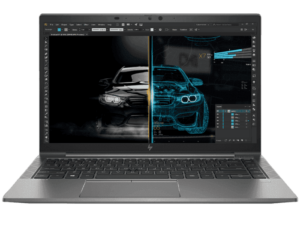 At the end of the day, the HP ZBook Firefly 14 G8 is a solid offer when it comes to compact mobile workstations. The devil is in the details and that applies to this laptop as well – most of the goodies are optional which isn’t good news for most users because they have to pay extra if they need features like a Nano SIM card slot, NFC, fingerprint reader, SmartCard slot, and IR WebCam. As we said at the beginning of this article, even the backlight of the keyboard is an option.
At the end of the day, the HP ZBook Firefly 14 G8 is a solid offer when it comes to compact mobile workstations. The devil is in the details and that applies to this laptop as well – most of the goodies are optional which isn’t good news for most users because they have to pay extra if they need features like a Nano SIM card slot, NFC, fingerprint reader, SmartCard slot, and IR WebCam. As we said at the beginning of this article, even the backlight of the keyboard is an option.
The display (LGD06F1) has a good contrast ratio, it doesn’t use PWM for brightness adjustment, its viewing angles are comfortable, and the only cons are the narrow color coverage which comes with inaccurate colors. It should not be a problem if you aren’t using it for color-sensitive work.
The spill-resistant keyboard is great – it has long key travel, good “click”, and it’s silent. The trackpad is good too – it’s relatively big for a 14-incher, it has dedicated buttons, and the glass surface provides good gliding and accuracy.
The build quality of the machine is spot on. The aluminum build feels great while you’re holding the device in your hands – this thing is like a small tank. The lid can be opened with a single hand and it’s stable, the bezels around the display are thin, and the camera has a privacy shutter.
In terms of upgradability, the device is a bit of a hodgepodge. If you don’t need a dGPU, the iGPU-based machines have two RAM slots and they can handle up to 64GB of DDR4-3200MHz. The dGPU-enabled laptops come with soldered memory (but luckily it can be in dual-channel mode) so you have to be careful when you’re configuring this kind of device – the maximum supported memory capacity is 32GB of DDR4-3200MHz. Storage-wise, we have just a single M.2 slot and that’s a bit of a disappointment. At least you can slap one big 2TB NVMe drive and this can be a real problem solver if you need more space.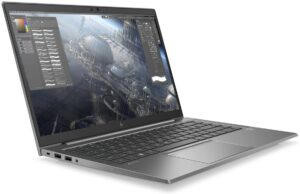
The cooling solution has two sides – the good one is the quietness during any kind of load and the bad side is the low CPU clock during heavy stress. At least the thermals of the CPU and the GPU are in check. The additional comfort comes from the fact that the WASD section and the palm rest area aren’t too warm during gaming or in some CPU-heavy stress. Last but not least – the battery life is just great.
The HP ZBook Firefly 14 G8 is a compact workstation that has a quiet cooling solution and a silent keyboard. It has decent Intel Tiger Lake-UP3 CPU options, and you need a dedicated GPU, there is an NVIDIA Quadro T500 option. The notebook is compact, light, and well-built. At the same time, it has a decent I/O, great touchpad and keyboard, and you can choose between five display variants including touch screen panels.
You can check the prices and configurations in our Specs System: https://laptopmedia.com/series/hp-zbook-firefly-14-g8/
Pros
- The cooling solution is quiet no matter the load
- The keyboard is silent and it’s spill-resistant at the same time
- Exceptional battery life
- Supports up to 64GB of DDR4 memory (iGPU-only based devices)
- Thin, light, and well-built
- Great touchpad
- Optional IR face recognition and fingerprint reader
- Comfortable input devices
- Five display variants
- Doesn’t use PWM to adjust its brightness (LGD06F1)
Cons
- Most Quadro T500 configurations are a little bit on the expensive side
- Lacks an SD card reader
- Most of the goodies are optional
- The panel isn’t color accurate (LGD06F1)


